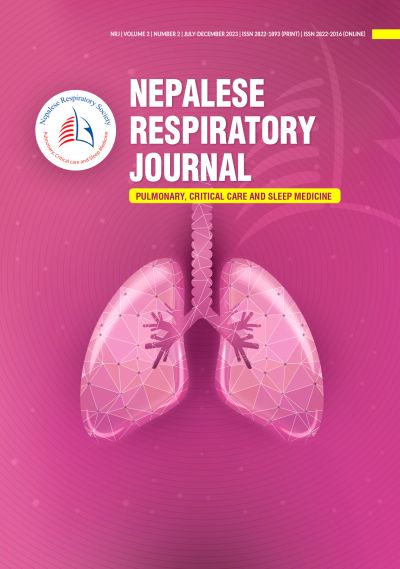Clinical response to withdrawal of Inhaled Corticosteroids in stable mild to moderate chronic obstructive pulmonary disease in a tertiary hospital of central Nepal
DOI:
https://doi.org/10.3126/nrj.v2i2.69192Keywords:
Chronic Obstructive Pulmonary Disease, Inhaled CorticosteroidAbstract
Introduction: The mainstay treatment according to the Global Initiative for Chronic Obstructive Lung Disease 2023 guidelines for Chronic Obstructive Pulmonary Disease is combination of long acting bronchodilators with addition of inhaled corticosteroids only in patients with increased exacerbations and an eosinophil count of ≥ 300 cells/μL. Despite the recommendations, inhaled corticosteroids are most commonly overprescribed. So, this study aims to follow patients with mild to moderate cases of this disease who are currently on inhaled corticosteroids combination therapy for clinical efficacy after its withdrawal.
Methods: The study was a prospective interventional study conducted at Dhulikhel Hospital that followed individuals with mild to moderate COPD for eight weeks after a sudden ICS withdrawal. Forced Expiratory Volume in first second, modified Medical Research Council grading, COPD Assessment Tool score and number of exacerbations were assessed with follow-up either by telephone or face to face.
Results: Total of 33 patients were enrolled in the study with mean age 68.9 years and standard deviation 9.3 years. Paired t-test analysis showed no significant mean difference in Forced Expiratory Volume in first second and COPD Assessment Tool values before and eight weeks after the withdrawal of Inhaled Corticosteroids.
Conclusions: Our study supported the conclusion of previous larger studies that withdrawing ICS in stable mild to moderate COPD patients makes no difference in clinical symptoms and spirometry.
Downloads
Downloads
Published
How to Cite
Issue
Section
License
© Nepalese Respiratory Society

This article is licensed under a Creative Commons Attribution 4.0 International License.




